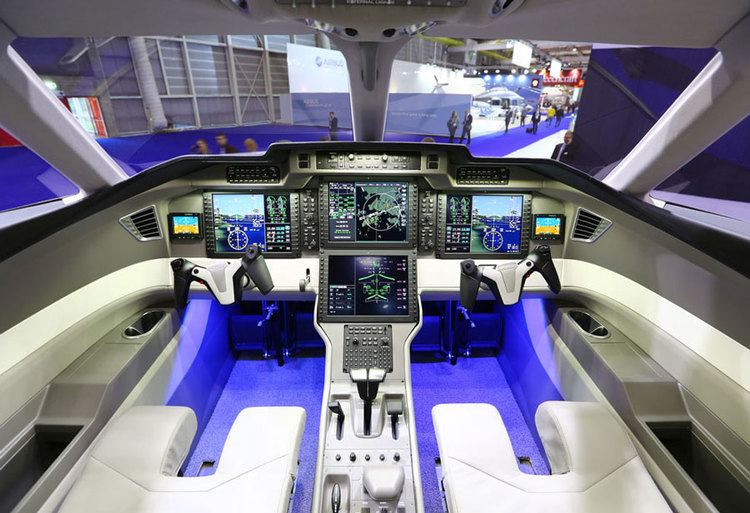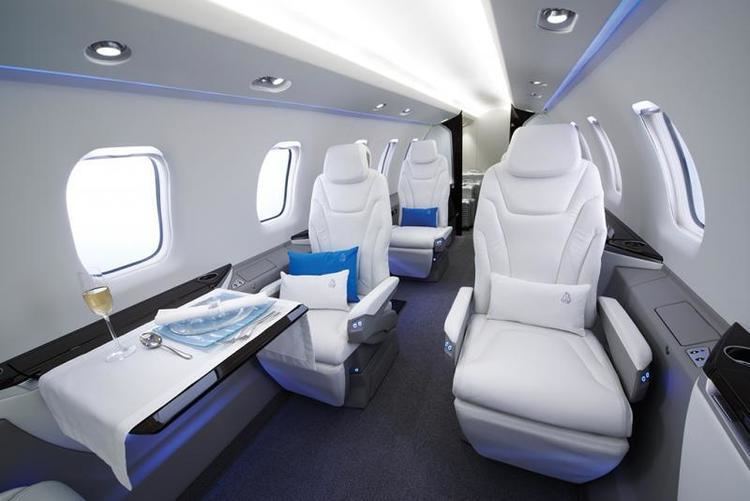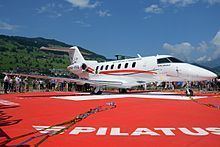Range 3,610 km Wingspan 17 m Engine type Twinjet | Top speed 787 km/h Length 17 m | |
Speed payload and runway performance come together in pilatus pc 24 aintv
The Pilatus PC-24 is a twin-engine business jet under development by Pilatus Aircraft of Switzerland. On 21 May 2013, the aircraft was first revealed to the public; and on 11 May 2015 the maiden flight for the type was performed. The PC-24 is anticipated to enter service in mid-2017.
Contents
- Speed payload and runway performance come together in pilatus pc 24 aintv
- Pilatus pc 24 business jet debut at nbaa
- Development
- Design
- Operational history
- Specifications PC 24
- References
Pilatus pc 24 business jet debut at nbaa
Development
During the 1990s, Pilatus Aircraft had brought to market the Pilatus PC-12, a single-engine turboprop-powered business aircraft. As the PC-12 quickly proved to be a commercial success, Pilatus sought to follow up with a complementary aircraft and began gathering feedback from customers of the type. In response to this request, several customers reportedly expressed a desire for an aircraft that would possess both a greater range and top speed than the existing PC-12, while retaining the type's overall ruggedness and ability to make use of very short runways. Based on this feedback, Pilatus elected to pursue development of such an aircraft. In 2007, Pilatus initiated work on the program. Development of the aircraft was conducted using existing company funds.

Designated as the PC-24, Pilatus decided that the new design would use jet propulsion, choosing to power the type using a pair of Williams FJ44 engines; the PC-24 is the company's first jet-powered aircraft. Beyond the propulsion choice, several other unique features were developed for the PC-24; Pilatus and Honeywell cooperatively designed the Advanced Cockpit Environment for the type. This is intended to reduce pilot workload and allows the PC-24 to be single-pilot certified. Several competing business aircraft were identified early on, including Embraer's Phenom 300 and Cessna's Citation CJ4.

On 21 May 2013, the PC-24 was introduced to the public at the European Business Aviation Convention & Exhibition (EBACE) in Geneva. At the time, Pilatus chairman Oscar Schwenk claimed the PC-24 did not fit into any existing business jet categories, and stated that the aircraft was the only one that combined "...the versatility of a turboprop with the cabin size of a medium light jet, and the performance of a light jet".

On 1 August 2014, which was also Switzerland's national day, P01, the first of the three PC-24 prototypes, was rolled out. Each of these three prototypes serve different functions in the development program; P01 is intended for exploring the flight envelope of the type, P02 is mainly for trialling the avionics and autopilot integration, and will spend much of its testing life in the US, while P03 is to be representative of production aircraft and will incorporate improvements made based upon the development work performed with the other two aircraft.

The first flight of the prototype had been originally anticipated to take place in late 2014, but this was delayed. On 11 May 2015, P01 conducted its first flight from Buochs Airport, Switzerland, for a total of 55 minutes. The occasion marked the start of test flights for the aircraft's two-year certification campaign. On the date on which P01 made its first flight, type certification of the PC-24 and subsequent initial deliveries of production aircraft were anticipated to occur in 2017.
On 16 November 2015, P02, the second prototype, performed its maiden flight, lasting for 82 minutes; by this date, P01 had accumulated a total of 150 flying hours and had performed over 100 flights. In May 2016, P01 took an brief intermission in the test program to appear on static display at EBACE; by this point, P01 and P02 had accumulated more than 500 flight hours between them. During EBACE 2016, it was commented that the program was on track and test flights had been free of surprises; during a transatlantic crossing to the US, P02 had achieved a cruise speed in excess of 800 km/hr (432 kt.), which was better than expected.
The interiors of the PC-24 have been designed by BMW Designworks; interiors for the Americas are to be completed at a facility in Broomfield, Colorado, which will be expanded by 50% to cope with the extra demand. In late 2014, an agreement between Pilatus and FlightSafety International will see the latter conduct US-based PC-24 pilot and technician training in Dallas, Texas.
Design
The PC-24 is a twin-engine business jet, a larger jet-powered follow-on to the earlier Pilatus PC-12. It is considered to be a short takeoff and landing (STOL) aircraft, being designed to operate from short and rough airstrips. It incorporates an advanced wing design, with a large double-slotted flap system to achieve the necessary performance, having a stall speed of only 81 knots at the maximum landing weight. Pilatus has claimed that the PC-24 possesses performance attributes which are unmatched by any jet aircraft on the market. It possesses a takeoff distance of 820 m (2,690 ft) and a landing distance of 770 m (2,526 ft). The PC-24 is intended to be capable of operations from unpaved runways and grass strips. According to Pilatus, no other business jet has this ability, which gives the jet access to over 21,000 airports; this is claimed to be twice the number of tarmac airports that are usable for similar-sized jet aircraft.
The large cabin of the PC-24 can accommodate a luxurious interior outfitted with modern features for comfort and functionality. The cabin is designed to provide first class accommodation for both passengers and crew. A fully enclosed, externally serviceable private lavatory is also present. The cabin is designed to facilitate rapid reconfiguration, giving greater operational flexibility and mobility; the passenger seats can be installed or removed within minutes, while the aft partition between the pressurized baggage compartment and main cabin is movable to increase or decrease the size of either, in between flights. A variety of interior configurations are possible, including a six-seat executive configuration (including a sizable baggage area); a combi version using four executive seats and a fully expanded cargo area; and an open version.
An unusual feature of the aircraft is the large cargo door, which is fitted as standard on all aircraft. According to Pilatus, the PC-24 is the first business jet to be fitted with this standard pallet-sized cargo door. The cargo door provides direct access to the heated and fully pressurized luggage compartment. This feature is useful for air medical services, utility and special mission operators. The door and baggage compartment are both capable of accepting a standard pallet; the compartment itself is deliberately located close to the aircraft's center of gravity to minimize the impact of heavy cargo. The trailing edge of the wing is reinforced against instances of incidental damage during loading/unloading. The design was optimized for special missions and by government customers.
The cockpit of the PC-24 is designed for efficiency and to reduce pilot workload. Marketed as the Advanced Cockpit Environment (ACE), information is displayed on four 12-inch liquid-crystal displays (LCDs). Pilatus selected Honeywell to develop and supply the ACE avionics suite. It uses some of the same avionics used in the Pilatus PC-12, in addition to those developed specifically for the PC-24. Standard avionics equipment includes a synthetic vision system, autothrottle, Traffic Collision Avoidance System (TCAS II), localizer performance with vertical guidance and graphic flight planning system.
The PC-24 is powered by a pair of Williams FJ44-4A turbofan engines. A unique feature of the FJ44-4A powerplant is the Quiet Power Mode; in addition to providing thrust and main power, standby power is also drawn from the main engines in Quiet Power Mode, in place of a separate auxiliary power unit (APU). An additional 5 per cent is available via an Automatic Thrust Reserve feature. The engines are mounted on the upper portion of the rear fuselage to prevent foreign object damage (FOD) during operations at rough airstrips. Other FOD-reduction measures include the enlarged flaps and chines on the nose wheel of the landing gear. The exhaust ducts of the engines feature an aerodynamic modification, having been shaped so the outflow contributes to the thrust vector during takeoff, reducing the takeoff roll distance.
Operational history
In May 2014, Pilatus briefly took orders for the PC-24; the company has claimed to have sold 84 production places within the first 36 hours, each with a $250,000 deposit; these orders represented the first three years of planned production from 2017 to 2019. Pilatus stopped accepting orders at this point, and will accept new orders closer to 2020.
The Royal Flying Doctor Service of Australia has ordered one aircraft for rapid medical evacuations and hospital transfers.
Potential customers include the Swiss Air Force, which intends to use the jet as an executive transport for the Swiss Federal Council.
Specifications (PC-24)
Data from Manufacturer
General characteristics
Performance
